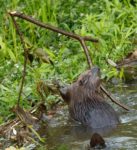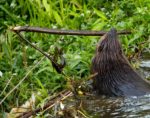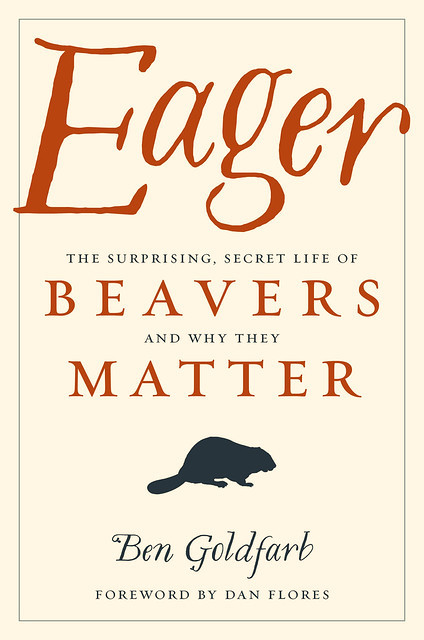Look up! Now that’s a beautiful header image. Don’t you think? Cheryl took a few photos that are long enough to be stretched across or bow, as it were, so I plan to experiment with them. There’s a ton of news to catch up, some of it glorious and some of it grim, which do you want first? Let’s intersperse.
A few more articles like this and I’m going to say we’re in the middle of a full cultural beaver renaissance!
Beavers important to water systems
The subject of this month’s visit is the beaver.
This amazing, large rodent is very important to water systems and aquifers.
It al so used to be thought that beaver dams would keep spawning steelhead and salmon from getting upstream, and so many beavers were trapped, shot and their dams blown up to open channels up for fish to get upstream.
so used to be thought that beaver dams would keep spawning steelhead and salmon from getting upstream, and so many beavers were trapped, shot and their dams blown up to open channels up for fish to get upstream.
This whole idea was not correct, and the destruction of beavers and their dams was a very bad idea, as the very fish we thought we were assisting were deprived of pools and water.
There is an old saying that states, “Beavers taught steelhead to jump.”
Beavers, water, habitat and fish are all connected just as tightly as your hand is to your arm. The trees and willows that beavers cut down have adapted to survive beavers by re-growing at great rates and in large numbers, as the water table rises due to the beavers’ dams.
Beavers are vital to all aquatic species.
Starting in the late 18th and through the 19th centuries, humans decided to go after the beaver for its winter pelts.
By the early 20th century, many Western drainages had all or most of the beaver populations trapped out.
As a result of this, water tables vanished, rendering many areas deserts and all plants and animals that depended on the beaver’s dams and pools suffered greatly.
So now we know that beavers are super important to any drainage they are in and that water managers need to protect these amazing engineers.
As more and more folks move into areas and demand more water, then the beaver will become all that more important.
Beavers are important for the species that need water to live, which is as it happens, every species, Thanks for the lovely column Mike Denny! Apparently he attended a lecture by Sarah Koenisberg earlier in the year and cemented his belief in beavers. I love when acolytes keep spreading the word!
Okay lets visit the ridiculous bad news now. I swear that people who can’t find beaver solutions in Massachusetts are like people who can’t find ‘anything to read’ at the library!
Beaver dam bedevils Oxford property owner
OXFORD – As a retiree with a place on Cape Cod, Charles Tuite doesn’t normally spend much time in Oxford these days, but beavers are forcing the 75-year-old disabled property owner to regularly travel to town deal with a problem they are creating.
Beavers, using logs and branches fallen and dumped into Barbers Hollow Brook, built a 7-foot dam at a culvert that runs under Mr. Tuite’s property and Route 12 at 381 Main St. The flooding by the dam put septic systems upstream at risk, according to environmental consultant Glenn Krevosky. The brook passes several hundred feet from McKinstry Pond. Although the culvert is owned by the state Department of Transportation, the dam became Mr. Tuite’s problem because he owns the land where the beavers chose to build.
 Mr. Tuite said he was offended by the letter threatening fines. He said he has been a property owner in town for 35 years and was never a problem. He said he would have been happy to talk with the health inspector and figure out a plan for dealing with the problem. The culvert runs under property where Gene Buckley operates Buckley Auto Center. Mr. Tuite said he he purchased much of the land nearby at the request of the town, which was concerned that a business next door did not have a safe parking area.
Mr. Tuite said he was offended by the letter threatening fines. He said he has been a property owner in town for 35 years and was never a problem. He said he would have been happy to talk with the health inspector and figure out a plan for dealing with the problem. The culvert runs under property where Gene Buckley operates Buckley Auto Center. Mr. Tuite said he he purchased much of the land nearby at the request of the town, which was concerned that a business next door did not have a safe parking area.
With the purchase, he ended up with the unexpected beaver problem. He said he was hoping the town could provide equipment to remove the dam or the beavers or both, but was told it was his responsibility. He went ahead and did what he could on his own. The task was not easy, he said.
“We had to pull a lot of logs out there by hand,” he said.
Mr. Tuite said he should not be doing the work himself because he is disabled, but was under threat of having the town fine him. In order to remove the dam, people had to climb down a steep 15-foot embankment and then haul the debris back up.
Mr. Tuite said four truckloads of debris were removed from the dam over the past several weeks, but the beavers are still at it. He said he was amazed at how large they are.
“They’re huge,” he said. “I hope they don’t attack us when we are removing the dam.”
Oh pulleeze! Beavers might attack you? I might attack you, does that count? Honestly, when people don’t know that there is a better way to solve a culvert problem than pulling at the logs and hoping the beavers give up, in FRIGGIN MASSACHUSETTS what is the world coming too.

I’m from a town in California that had to bring an expert 3000 miles to solve our beaver problem. You only have to pick up the phone. If you don’t know better by now its because you don’t want to know better, Just remember to keep the numbers of the health inspector and trapper handy, cause you’ll be doing this again next year or the year after that.
Good news please! I need something to clean my palate after that mouthful of stupid. Dr. Joe Wheaton from Utah just finished Ben’s book and is plugging it proudly on his website. Let’s hope its required reading on campus soon!
Ben Goldfarb’s longawaited Eager book is out! Worth the wait!
This is one of the most exhaustively researched, authoritative and compelling books on why we might want to turn to beaver as a restoration and conservation partner in existence. Even if you are a seasoned beaver researcher or restoration practitioner, you will learn a ton reading this and be pointed to all sorts of great references and research that Ben uncovered and synthesized. Perhaps more importantly, if you’ve never paid any attention to this rodent, Ben makes it easy to become interested in their plight and how our’s is so intertwined. Ben tells the parallel stories of beaver, North America’s complicated history with the rodent, and of the large cast of contemporary characters involved in trying to shape the future of trying to learn something from this amazing ecosystem engineer in about how we manage natural resources and coexist.
Excellent introduction Joe! I can feel the beaver believer tally rising as I type! I saw this photo yesterday on Ben’s instagram account and just had to share, You may recognize the mural behind him. He had just finished picking up his copies delivered to the house.

Tomorrow is publication day in Chicago. Fingers crossed!

















 es bursting with the paper trail of Perryman’s campaign. I leafed through the documentary evidence of her struggle: pre-stamped, pro-beaver postcards she’d handed out to pedestrians on the bridge; articles she’d written for the Martinez News-Gazette; lyrics to a Blue Oyster Cult parody song (“City don’t kill the beavers”). The San Francisco Chronicle and Los Angeles Times covered the quirky controversy. The city announced that the California Department of Fish and Wildlife would live-trap the animals and relocate them to tribal land, assuming this would mollify the beaver freaks. The freaks were not mollified. Schoolchildren stood on the bridge and chanted “Leave her, leave her, save Ms. Beaver!” Even the city’s Wikipedia page became a hotbed of dispute, a battleground between editors praising Martinez’s beavers and anonymous trolls castigating them.
es bursting with the paper trail of Perryman’s campaign. I leafed through the documentary evidence of her struggle: pre-stamped, pro-beaver postcards she’d handed out to pedestrians on the bridge; articles she’d written for the Martinez News-Gazette; lyrics to a Blue Oyster Cult parody song (“City don’t kill the beavers”). The San Francisco Chronicle and Los Angeles Times covered the quirky controversy. The city announced that the California Department of Fish and Wildlife would live-trap the animals and relocate them to tribal land, assuming this would mollify the beaver freaks. The freaks were not mollified. Schoolchildren stood on the bridge and chanted “Leave her, leave her, save Ms. Beaver!” Even the city’s Wikipedia page became a hotbed of dispute, a battleground between editors praising Martinez’s beavers and anonymous trolls castigating them.
 0The battle lurched on into 2008. Perryman, finding the Internet lacking, scoured the country for beaver-smart professionals to advise the city, stumbling finally upon Skip Lisle and Beaver Deceivers International. At Perryman’s recommendation, the city spent $10,500 flying Lisle from Vermont to Martinez to install a Castor Master. The News-Gazette commemorated the event by running a front-page photograph of Lisle mucking around in the pond, bare arms rippling in the sunshine, below the headline “Burly Beaver Biologist Breaks a Sweat.” A yellowed copy of the article — signed BBB by the burly beaver biologist himself — is pressed into Perryman’s scrapbook. “I’ve never had media coverage like that,” Lisle marveled to me. “Every news outlet in San Francisco seemed to be there.”
0The battle lurched on into 2008. Perryman, finding the Internet lacking, scoured the country for beaver-smart professionals to advise the city, stumbling finally upon Skip Lisle and Beaver Deceivers International. At Perryman’s recommendation, the city spent $10,500 flying Lisle from Vermont to Martinez to install a Castor Master. The News-Gazette commemorated the event by running a front-page photograph of Lisle mucking around in the pond, bare arms rippling in the sunshine, below the headline “Burly Beaver Biologist Breaks a Sweat.” A yellowed copy of the article — signed BBB by the burly beaver biologist himself — is pressed into Perryman’s scrapbook. “I’ve never had media coverage like that,” Lisle marveled to me. “Every news outlet in San Francisco seemed to be there.”
 NORTH SMITHFIELD – Paul Soares is on a mission. He has a bone to pick with local wildlife, but it’s not squirrels eating from the birdfeeder or mice in the attic he’s worried about. Instead, the resident and chairman of the North Smithfield Conservation Commission is determined to do something about the beavers that moved into a section of public land near Rte. 146 a few years ago and quietly staked their claim, keeping it all but inaccessible to the humans who live nearby.
NORTH SMITHFIELD – Paul Soares is on a mission. He has a bone to pick with local wildlife, but it’s not squirrels eating from the birdfeeder or mice in the attic he’s worried about. Instead, the resident and chairman of the North Smithfield Conservation Commission is determined to do something about the beavers that moved into a section of public land near Rte. 146 a few years ago and quietly staked their claim, keeping it all but inaccessible to the humans who live nearby. “When the flooding is at its worst, this is all underwater,” Soares explained. “People can’t walk through here, and there’s 40-some acres of beautiful highlands you can’t get to.”
“When the flooding is at its worst, this is all underwater,” Soares explained. “People can’t walk through here, and there’s 40-some acres of beautiful highlands you can’t get to.”
 Do you know the story of Johnny Appleseed? He was a pioneer hero who famously walked all of Pennsylvania, Ohio, Ontario and Illinois bearing apple seeds and a shovel to spread the crisp good news. Never mind that he was more
Do you know the story of Johnny Appleseed? He was a pioneer hero who famously walked all of Pennsylvania, Ohio, Ontario and Illinois bearing apple seeds and a shovel to spread the crisp good news. Never mind that he was more 



































